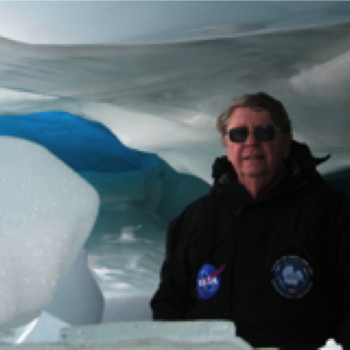Life in the Universe
Special Date. Tuesday, February 5, 2019 at 7 pm at Huntsville-Madison County Main Public Library Main Auditorium, with Richard B. Hoover. Visiting Research Professor, Buckingham Ctr. for Astrobiology, Univ. of Buckingham, UK Astrobiology Laboratory; Director, Athens State University, Athens, Alabama.

Abstract
Recent discoveries suggest the current paradigm of the origin of life on
Earth may be invalid. The long-held hypothesis is that life originated
as protocells developed after a long, slow chemical evolutionary process
formed amino acids and other pre-biotic organics in Earth's primordial
atmosphere and oceans. The concept that all life on Earth evolved from
these protocells led to the belief that Earth was uniquely suited for
life. Scientists often search for "Goldilocks Worlds" exoplanets. This
is based on the mistaken belief that life could exist only on earthlike
planets with unfrozen liquid water oceans.
Expeditions to Siberia, Iceland, and Antarctica have shown that life
exists in ice. Living microbial extremophiles are often abundant in the
frozen permafrost, glaciers and polar ice caps of our planet. Hot
crustal rocks of the deep continental subsurface are home to a vast
ecosystem chemolithotrophic microorganisms. Bacteria and archaea that
inhabit the hot, deep, crustal rocks may comprise more biomass than all
life of the oceans and surface of Earth. Astonishingly, the primary
producers in this dark, deep, hot biosphere have been found to be
hydrogen-based lithoautotrophic cyanobacteria (species of Calothrix and
Microcoleus) that were previously thought to require light for
photosynthetic metabolism. Fossilized cyanobacteria of these genera were
discovered at NASA/MSFC during Scanning Electron Microscopy studies of
carbonaceous meteorites. Failure to detect nitrogen in these filaments
by Energy Dispersive X-Ray Spectroscopy proves the fossils are
indigenous and therefore extraterrestrial in nature.
It is now well-established that living organisms are present on Earth
everywhere water and energy co-exist with a small group of bioelements
(mainly C, H, O, N, P and S) that are essential for organic molecules.
Space Probes and Missions have recently shown that water (solid and/or
liquid), energy and organics co-exist on virtually every comet, planet,
planetoid, and moon of our Solar System. On December 3, 2018, the NASA
OSIRIS-REx spacecraft arrived at 101995 Bennu. Spectroscopic data
revealed abundant hydrated clay minerals (indicative of water and
possibly life) on the parent body of this tiny carbonaceous asteroid.
The large, red Transneptunian object (TNO) 50000 Quaoar exhibits
evidence for crystalline water ice, cryovolcanism and organics. On Dec.
31, 2019, the New Horizons spacecraft flew within 2,200 miles of
Ultima Thule and obtained images of a binary object with red color indicating
tholin-like organics.
Microfossils and organic biosignatures reveal that life appeared on
Earth some 3.9 billion years ago, near the end of the Late Heavy
Bombardment. Hence, there is no time for the long, slow chemical
evolution process on Earth or on any other body of our Solar System.
This presentation will present the recent discoveries of diatoms and
exotic cyanobacteria indigenous to the Orgueil CI1 carbonaceous
meteorite as additional evidence for the existence of extraterrestrial
life. The hypothesis that earthlife may have originated in a nearby but
much more ancient Solar System and transferred to Earth by an
interstellar comet will be advanced. Kapteyn's star and its planets
(which could conceivable support life) were over 6 billion years old
when the proto-solar nebula condensed to form the Sun and planets of our
Solar System. Kapteyn's planetary system passed within 7 light-years of
Earth in 8000 BC. The interstellar comet Oumuamua will be discussed. It
is known that bacteria survive for millions of years in desiccated state
in salt crystals or cryopreserved in ancient permafrost or glaciers.
Furthermore, microorganisms can survive long duration exposures to the
hard vacuum of space and temperatures near absolute zero. Some species
are extremely resistant to radiation and the possible relevance of these
properties of microbial life to the hypothesis that early Earth might
have been contaminated by life forms from an ancient proximate star
system will be considered.
About Richard Hoover

Richard B. Hoover joined the NASA/Marshall Space Flight Center (MSFC) as a Research Scientist in 1966. He retired from
NASA in 2012 and is now Visiting Research Professor, Centre for Astrobiology at the University of Buckingham in the UK, and the
Astrobiology Laboratory at Athens State University. His initial research at
NASA/MSFC was on Fraunhoffer diffraction and Laser Ranging Corner Cube Retro
Reflectors for the APOLLO Program. He was Co-Investigator for the SKYLAB
Apollo Telescope Mount S-056 X-ray Telescope that produced 25,000 x-ray images
of the Sun. He developed and tested the S-056 X-ray mirrors, monitored the
instrument from mission control during the missions and participated in
post-flight data analysis of the solar x-ray images. He holds 13 US Patents and
2 International Patents and was selected 1992 NASA Inventor of the Year and
Nominee for National Inventor of the Year.
Richard B. Hoover was selected a member of two of the initial programs of the NASA
Virtual Astrobiology Institute in 1997 for the to study microfossils in
Astromaterials (PI-David McKay) and microbial extremophiles (PI-Kenneth
Nealson). Hoover established the Astrobiology Research Group at MSFC and developed
collaborations with Academicians (Mikhael Ivanov Institute of Microbiology
and Alexei Rozanov Institute of Paleontology) of the Russian Academy of
Sciences. Prof. Hoover has organized and led scientific expeditions to explore
some of the most hostile environments of Earth - glaciers in Alaska and ice
caves in the high Alps, Iceland and Antarctica & volcanoes, geysers and
fumaroles Yellowstone, Crete and Iceland. He was Science Team Lead for the Antarctica
2000 Expedition (with Astronauts James A. Lovell (Gemini 7 & 12;
Apollo 8 & Apollo 13) and Owen Garriott (Skylab III & Spacelab),
which recovered new species of bacteria from southern Patagonia 20 meteorites
from the Thiel Mountains of Antarctica. He was Science Lead for the 2008 Joint
US/Russia/Austria TAWANI International Astrobiology Expeditions to the Schirmacher
Oasis and Lake Untersee in Antarctica. He carried the Explorers
Club Flag #162 on two Expeditions to Antarctica and was elected a Fellow
of the Explorers Club. These Expeditions resulted in the discovery of fifteen
new species and six new genera of archaea and bacteria. Williamwhitmania
taraxaci, isolated from Lake Untersee, Antarctica represents a new Family
(Williamwhitmanaceae) with previously unknown organelles for gliding motility (antiae).
Hoover has discovered the fossilized remains of cyanobacteria and other living
and extinct algae in diverse carbonaceous meteorites. The absence of nitrogen
in these microfossils indicate they represent microorganisms that died long
before the meteorites entered Earth's atmosphere. Based on his research on
microfossils in meteorites he was made an Honorary Life Member of
the Planetary Studies Foundation. He was the 2001 President of SPIE,
the International Society for Optical Engineering and was awarded the Gold
Medal of the Society in 2009. He has Authored/Edited ~50 volumes and more than 400
scientific papers on topics as diverse as Fraunhoffer Diffraction, X-ray
Astronomy, X-Ray/EUV optics, Solar Physics, Astrophysics, Diatoms, Microbial
Extremophiles, Meteorites and Astrobiology. Prof. Hoover's scientific research
has been featured in TV programs on the History Channel, Science
Channel, NASA's Unexplained Files, NHK Japan Television and films
produced by the National Science Foundation, BBC, Discovery Channel and
National Geographic and he has delivered scientific lectures on every
continent on Earth.
Visiting Research Professor, Buckingham Ctr. for Astrobiology, Univ. of Buckingham, UK
Astrobiology Laboratory, Director, Athens State University, Athens, Alabama, USA
e-mail: RichardBHoover@icloud.com; Phone: +1 (256) 337-4082
Huntsville-Madison County Main Public Library Main Auditorium
Huntsville-Madison County Main Public Library is located at 915 Monroe Street in downtown Huntsville. The main auditorium is on the right when you come in the main entrance.

